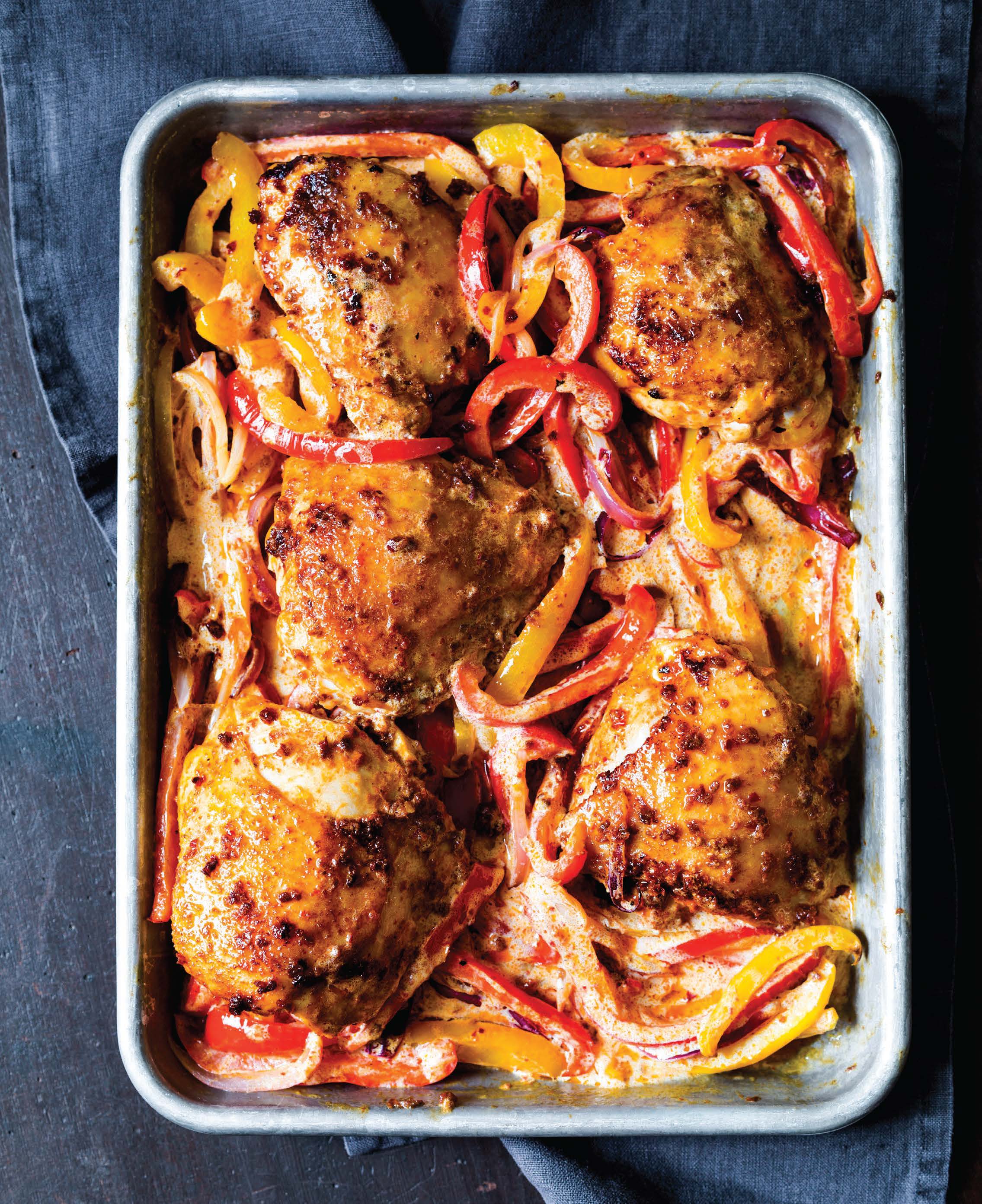Special Feature: Products Sally Recommends
harissa roasted chicken with sweet peppers
by Janet Fletcher
Serves 6
 1 ⁄ 2 cup plain drained yogurt or Greek-style yogurt (not nonfat)
1 ⁄ 2 cup plain drained yogurt or Greek-style yogurt (not nonfat)
1 ⁄ 2 cup coarse harissa paste (see note)
1 tablespoon freshly squeezed lemon juice
Kosher or sea salt and freshly ground black pepper
6 bone-in, skin-on chicken thighs, trimmed of excess skin
2 large red bell peppers, halved, seeded, and thinly sliced
2 large gold or yellow bell peppers, halved, seeded, and thinly sliced
1 large red onion, halved and thinly sliced
The yogurt marinade makes this chicken especially tender and juicy, while the harissa stains it brick-red and adds tongue-tingling spice. Depending on how fiery your harissa is, you may want to increase or reduce the amount you use. Taste and adjust the marinade before adding the raw chicken.
I’ve adapted this recipe from one given to me by Ed Blonz, a clinical nutritionist and syndicated columnist, who makes it when his book club comes for dinner. Ed roasts the chicken on a bed of chickpeas and onions. I like it with sweet peppers underneath. The vegetables absorb the spicy drippings from the chicken and need no further seasoning.
If your menu includes several other dishes, figure one chicken thigh per person. Otherwise, you may want to allow two thighs per person. The roasted chicken benefits from a brief rest to allow the juices to settle.
In a large bowl, whisk together the yogurt, harissa, lemon juice, 1 teaspoon salt, and several grinds of black pepper. Add the chicken and use a rubber spatula to coat the chicken all over with the marinade. Cover and refrigerate for 4 to 8 hours. Remove from the refrigerator 30 minutes before baking.
Position a rack in the upper third of an oven and preheat the oven to 425°F.
Toss the sliced peppers and onions together. Season with salt and make a bed of the vegetables in the bottom of a roasting pan large enough to hold the chicken in a single layer. Using a rubber spatula, redistribute the marinade so that it evenly covers both sides of the chicken, and then place the chicken on top of the vegetables. Bake until the chicken is well browned on top and the vegetables are tender, about 40 minutes. Remove from the oven and let rest for 10 minutes.
Transfer the chicken to a serving platter. Using tongs, toss the vegetables to coat them evenly with the drippings from the chicken, and then place them on the platter with the chicken. Serve immediately.
HARISSA PASTE
Harissa paste comes in tubes‚ like toothpaste‚ but my favorite brand is a jarred one‚ Les Moulins Mahjoub Organic Traditional Harissa Spread. The recipe includes hot red pepper‚ sun-dried tomato‚ olive oil‚ caraway‚ and garlic. If you can’t find harissa paste‚ purchase dried harissa powder from a spice shop and add enough extra-virgin olive oil to make a paste. Ask the merchant about the ingredients in the powder. If the blend doesn’t contain ground caraway‚ add a good pinch. Look for Les Moulins Mahjoub harissa in specialty foods stores that sell Mediterranean products. It is also available from several online sources‚ including Zabar’s‚ iGourmet‚ Market Hall Foods‚ and Bklyn Larder.
Making Drained Yogurt
I often drain yogurt, especially homemade yogurt, even if only for an hour. Draining dramatically improves the texture, making any yogurt thicker, creamier, and more mellow by removing whey. Draining also extends the yogurt’s life by removing water and lactose. Reducing the yogurt’s lactose deprives bacteria of their food source. And if you are lactose-sensitive, you should find drained yogurt more digestible.
To drain homemade yogurt, chill it thoroughly first until it is firm. You can drain it as soon as it is cold. Store-bought yogurt has already been chilled, so you can drain it immediately after opening.
Line a large sieve or colander with a triple thickness of dampened cheesecloth or—my preference—with Plyban, a reusable cheesecloth made from a food-grade resin (see Resources, page 135). Plyban’s weave is tighter than cheesecloth, so you don’t need multiple layers, although with very thin yogurt I might use a double thickness.
Set the sieve or colander over a bowl to collect the whey. Gently pour the yogurt into the lined sieve or colander. Cover with a plate or cloth—you’re just protecting the yogurt, not pressing it—and refrigerate. Drain the yogurt until it has the consistency you like. After an hour, it will be noticeably thicker, and I usually stop at that point.
Scrape the drained yogurt into a clean container, cover, and refrigerate.
Wash the cheesecloth or Plyban well in hot, soapy water; rinse well and air-dry. You can usually get two or three uses out of cheesecloth before it frays. Plyban is much longer-lasting and easier to clean.
If you drain the yogurt more than you intended, no problem. Simply whisk some of the whey back in until you have a texture you like.
To keep the whey, pour it into a glass jar and refrigerate. It has many potential uses.
![]()
Reprinted with permission from Yogurt, by Janet Fletcher, copyright © 2015, published by Ten Speed Press, an imprint of Penguin Random House LLC.
Photographs copyright © 2015 by Eva Kolenko



